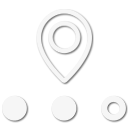There is a huge thread on QRZ about a ham emergency frequency (or lack thereof) with all kinds of back and forth. I went cross eyed a few times while reading it, but the consensus is the same as previously mentioned of 146.520 and 446.000 being the accepted national calling frequencies for emergencies. Etiquette then dictates the stations move a few MHz up or down after contact is made in order to pass more detailed info, if its an emergency, or to rag chew. Of course there's nothing actually enforceable about that, but its supposed to be common courtesy and not everyone does it in all areas.
Like Terry said, most with a dual band will generally have the "B" side of their radio tuned to one of the calling frequencies most of the time. I've got a Yaesu FTM-7250 in my Tundra, which is my daily driver. Its dual band, but not a true dual monitor radio like the FTM-400 I have in the 4Runner, but I do have an option to scan to a second frequency that I set it to at five second intervals. I generally stay on one of my local repeaters and let the radio do its thing in the background when I'm local. If it catches something on .52, then a quick push of a hot button on my mic will take me straight to it. With the 400, one side is generally on a repeater with the other on .52 or, if I'm travelling, the "A" side will be on .52 with the "B" side on either 144.390 for APRS if I want it to be known where I am without being asked or 446.000 if I don't. Either way, if somebody hollers, I'll usually hear them.




